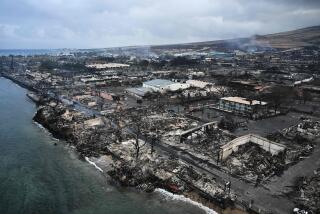Intrepid armchair explorers
ANDRE Mueller is a virtual explorer of virgin territory.
One morning, off the southwest coast of Iceland, the 25-year-old German physics student noticed a wispy line -- a wrinkle, almost -- in the elaborate patchwork of satellite imagery that makes up Google Earth.
He zoomed in for a closer look.
It was smoke.
At the end of the trail, he discovered what appeared to be three boats. He slapped a “placemark,” the program’s version of an explorer’s flag, on the location and reported his findings on the Google Earth Community bulletin board.
“What are these three ships doing there?” wrote Mueller, using the handle earthling_andre. “And why is there so much smoke?”
His fellow office-chair detectives showered him with praise for the discovery (“Now that’s an AMAZING FIND,” one replied), then went to work trying to solve the mystery of the burning ship.
Google Earth is packed with things that its creators never intended. Paper maps are a cartographer’s rendering of the world, whereas digital versions in Google Earth, Google Maps and Microsoft’s Live Search Maps are more like sophisticated collages -- moments captured by cameras on satellites and airplanes, seamlessly blended to create a digital world.
If inspected very closely, these photos from on high sometimes reveal life going on when the shutter opened and closed: airplanes in flight, surfers off Malibu, mourners congregating in a Chicago cemetery, a Boston Red Sox game underway at Fenway Park, a cement truck overturned in San Francisco.
“These are life’s moments that are unexpectedly caught from above,” said Jason Lee, 30, a Bellingham, Wash., marketer. He and computer programmer Jon Coogan run Bird’s Eye Tourist, a website that compiles things of interest submitted by users of a Live Search Maps feature known as bird’s eye view.
What may appear as a blemish to digital mapmakers is becoming sport for virtual discoverers. The hunt is on to find and share those moments.
The Google Earth Community and independent enthusiast sites such as Google Earth Blog, Google Sightseeing and Bird’s Eye Tourist serve as repositories for these finds, where people can discuss, for example, a submarine captured in a permanent state of departure from Tokyo Bay (the bow-wake characteristics and sail-to-rudder measurement suggest it is a Yushio class sub, a Google Earth Community veteran concluded).
John Hanke, director of Google Earth and Maps, said the hunt for interesting things reminded him of the Web’s early days, before search engines and directories.
“There’s a huge amount of undiscovered territory out there for these geo-explorers to go and explore,” he said.
Unlike famous explorers such as Capt. James Cook, these virtual voyagers can scour the globe with little physical effort or danger. Google Earth covers about 30% of the world’s land surface with high-resolution imagery. That’s a lot of ground to cover.
Mueller, the physics student, is an amateur astronomer and map buff. On July 26, 2005, as he sat at home in Aachen, Germany, he brewed some coffee and turned his attention to what he calls the “next-generation atlas” on his laptop.
First he activated a Google Earth feature that displays, as dots on the map, everything the program’s users had ever tagged as noteworthy. He then focused on the empty spots still covered by high-resolution satellite photos. By chance, he spotted the smoke trail leading to the ship in only minutes, about seven nautical miles off the coast of Iceland’s Reykjanes peninsula.
The first reply to his posting came nine minutes later. “That scene does not look good at all,” a visitor wrote on the community’s bulletin board, noting the presence of another ship that appeared to be racing to help. Another member pointed out yet another ship, heading back to shore.
Seven responses were posted in the first two days. One sleuth pinpointed the fire’s date; he activated a feature revealing that DigitalGlobe, the company that provides most of Google Earth’s satellite images, had shot the photo almost a year earlier, on Aug. 11, 2004.
But then the trail went cold, and the message board silent, for three weeks. Mueller thought that the answer would never come. It turns out Mueller just needed to find the right people in Iceland.
“On my own I could never find out what exactly I saw,” Mueller said. “But in the global village there is someone, somewhere, speaking Icelandic who knows just where to look in the right newspaper archive for details.”
*
PROGRAMS that compile satellite imagery into maps have long existed, but the expensive price tag left them the playground of government officials, academic researchers and real estate developers.
That changed in 2004 when Google bought Keyhole Corp., a company Hanke helped create to let users view satellite images over the Internet. Google immediately cut the price for a one-year subscription to the basic version of the mapping software to $29.95 from $69.95, then made it available free the following year. More than 200 million copies of the Google Earth software have been downloaded.
Microsoft soon followed with its own program, Windows Live Local, which is now called Live Search Maps. It, like Google Maps, is a Web-based program that does not require a software download.
There are many practical uses for Google Earth. Programmers have layered housing data on maps so that renters or home buyers can shop from above. Whale sharks, bike racers and professional sailors hooked up to global positioning systems have had their progress tracked as dots moving across the surface of the maps. Amateurs tooling around on Google Earth have found previously undiscovered meteor craters and Roman ruins.
And Google and Microsoft last week enlisted their mapping teams to seek something they hoped would appear in the satellite imagery: a missing computer scientist.
Microsoft researcher Jim Gray failed to return from a sailing trip in San Francisco Bay on Jan. 28. When word of his disappearance began to spread, Microsoft and Google worked their connections with satellite operators to shoot fresh photographs of the local coastline, then offered searchers software to analyze the images for signs of his boat. Other tech companies also pitched in, but Gray had yet to be found late Monday.
Many people, however, simply enjoy looking around these virtual worlds. New users typically start by seeing what their homes look like from above. Then maybe their offices or schools. Then popular landmarks near them. They might then do some virtual sightseeing before growing bored.
But some people keep looking.
Hanke of Google Earth and Stephen Lawler, his counterpart at Microsoft, say they don’t ask the photo providers to capture people or events -- it just happens. There’s so much raw footage being fed automatically into the mapping programs that human eyes never view the vast majority of the images before they’re published.
“It’s like a treasure hunt for people,” Lawler said.
Thomas Baekdal, 30, an Internet programmer in Denmark, has never been to Seattle. But he spent hours last spring on Microsoft’s map program, exploring nearly all of the city and its coastline. He also visited every football stadium in the United States, looking for games or practices captured in the footage.
“We live our lives about 6 feet off the ground,” he said. “Being able to move up into this virtual helicopter is really spectacular.”
Bird’s Eye Tourist accepted 34 of his submissions: parasailors near Seattle, windsurfers and sailboats near San Francisco, soccer practices in New Jersey and planes in the air and on runways.
“It’s not that exciting to just look at houses and monuments,” he said. “But being able to capture life somewhere on the planet -- that is fun.”
*
DISCOVERIES include those sad and silly.
Alan Glennon, a graduate student in geology at UC Santa Barbara, spent the day after Thanksgiving looking at burned-out villages and refugee camps in Darfur, Sudan, after Google Earth updated the program with higher-resolution images from Africa. Contributors to Google Sightseeing (motto: “Why bother seeing the world for real?”) compiled shipwrecks scattered along the coast of the Western Sahara and Morocco.
Meanwhile, Google Sightseeing has compiled a list of its 10 favorite images featuring nude sunbathers. The photos are clear enough to see that the sunbathers are probably wearing little or no clothing, but not sharp enough to go beyond that. Virtual tourists have found elephants and giraffes at the Los Angeles Zoo, sea lions on a pier in San Francisco, killer whales feeding at a marine park in San Antonio and what appears to be a great egret flying above a field near Bourne End, England.
Finding objects in midair is among the most competitive pursuits. Enthusiasts have meticulously cataloged hundreds of aircraft: commercial jets, retired SR-71 Blackbird spy planes, hang gliders, blimps, a KC-135 aerial tanker refueling a C-5 Galaxy Air Force transport plane in flight, even a plane with its wheels facing the sky as it completes a loop the loop.
It’s a Sisyphean task: Google and Microsoft periodically refresh the maps with new images, as often as every few months in more densely populated areas. So just when the plane-tagging hobbyists think they’ve discovered most of the planes, some disappear. The scramble starts again.
Long debates about the finds linger. The discovery of B-52 bomber carcasses near Edwards Air Force Base prompted a long discussion about their origin, including photographs and links to supporting documentation elsewhere on the Web.
“That’s what makes a difference,” said Hill Penfold, a retired teacher from Los Angeles who serves as a volunteer moderator on the Google Earth Community. “If there was none of that, you’d just look around and only once in a while you’d come back. It’s the collaboration that makes it interesting.”
Some mysteries go unsolved: In Live Search Maps, why is there a van or SUV sitting in the water off New York’s Staten Island? Is the smoke billowing from a car in Baghdad from a traffic accident or a bomb?
But in the case of the burning ship off Iceland, patience brought answers.
On Aug. 16, someone using the name “solskin” posted a link to a story on the Google Earth bulletin board, in Icelandic, about the incident. No direct translation to English was available, but the contributor said that the ship was the Eyrarrost KE-25 and that there was one man aboard, who was rescued.
“Nice piece of detective work guys!” member “tim_kent” responded.
On Sept. 9, “jonbg” posted an English translation of the story: “A man was rescued by a nearby boat after his boat had caught fire around noon today,” it began.
The story came full circle four months after Mueller’s original discovery. A member of an Icelandic search and rescue team stumbled across the online conversation and showed his colleague, Agnar Juliusson, who had captained the ship that DigitalGlobe’s satellite captured racing to the scene.
On Nov. 28, Juliusson posted his version of events on the Google Earth Community message board: His crew managed to put out the fire, but another boat interfered with the towing effort. The fishing boat “sank on site,” Juliusson wrote.
Google Earth enthusiasts marveled at the outcome.
“It really is sleuthing to figure out this stuff,” said Frank Taylor, a former NASA researcher in Cary, N.C., who runs Google Earth’s blog. “To capture a specific incident like that almost requires a community of millions of people before you find somebody who has the facts.”
*






